An interview with Amanda Lear / The GROUND Magazine Issue IV
London’s Swinging Sixties are over, Andy Warhol’s dead, and Studio 54 had shut his doors, but Amanda Lear is a woman with a strong and charismatic personality that never loses her focus and integrity. She may have been Salvador Dalí’s muse and had dated David Bowie, but she never lived in anyone’s shadow; she is the ultimate storyteller of her own life and an inspiring, self-made woman who can only be labeled with one word: Amanda.
First single, Elvis Presley Reprise
Talking with a unique, deep, trademark voice that makes her songs strangely ambiguous and exciting, the first thing I notice about Lear is her enchanting smile, her pink birkin Hermès bag, and how incredibly fun she is. Sipping coffee and eating macaroons, she tells me her explicit video for “La Bete et la Belle” was shot in the same room where Salvador Dalí used to stay in when in Paris. She was excited to tell me how theatre recently filled her artistic career and after touring extensively with “Lady Oscar,” Amanda is now rehearsing for her upcoming show “Divina,” a comedy with costumes designed by her friend, Jean Paul Gaultier.
“It all started three years ago,” she says, “and it was love at first sight. My life will be on stage from now on and I hope to bring my show over to Italy and the UK as well, where, unfortunately, people still think of me solely as a singer.
”In her previous show, Amanda describes her role as “this hateful character just like Anna Wintour; did you see me on the catwalk for Gaultier? Doing it in front of her, Grace Coddington, and all those mean, fashion ladies has been a personal vendetta for me.” As outspoken as I expected her to be, this time around, she will play a successful TV presenter whose career is endangered. As the real Amanda, she will find her way back on top, reinventing herself. Amada as, “singing or hosting a TV show are just other ways to act. I never had a voice like Barbra Streisand; in fact, my career as a singer was more about acting than anything else.”
When she talks about theatre, she does it with passion, but also with real commitment and respect. She says, “people need comedy at the moment. It is such a tragic, historical period so they pay to laugh, but I would love to play something more serious like Tennessee Williams as soon as my reputation as an actress grows.”
“When I act, I like to be someone else,” Amanda says, but also in terms of music, she changes her demeanor frequently. “There has always been music in my life. In France, they always put this label on me – ‘disco queen’ – and it bothers me because after so many albums, I would like to change and sing more melodic songs. People always like to shake their boots on the dance floor and that’s okay, but I titled my album, ‘I Don’t Like Disco’ for this reason.”
To my surprise, she nonchalantly opens up about her new project, the first-ever Elvis Presley cover album recorded by a woman. I unexpectedly notice that she refers to herself in third person, just like Salvador Dalí used to do, and the conversation skips from music to her modeling career when I mention the song, “I Am a Photograph” and a vibe of glamour travels across our Louis XVI-style suite.
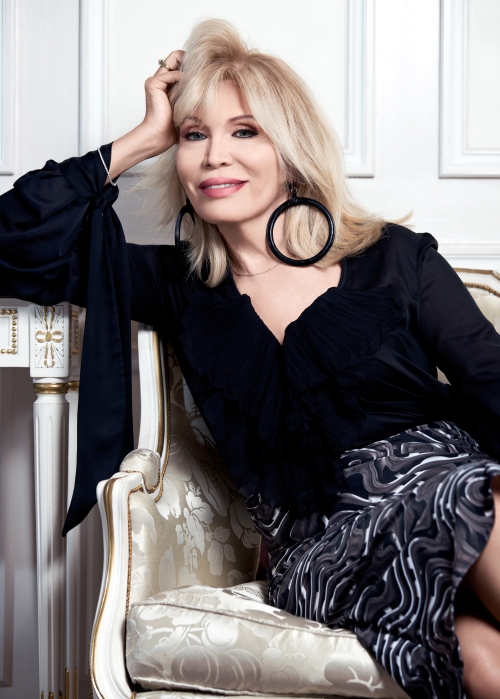
This one is for me, because i love too !!!!Magica !!!
Sometimes, a closer look into an artist’s body of work can reveal the most intimate, 360-degree view of the artist’s mind, life, feelings, and identity. Most of the time, it happens while paying attention to a song that may not have been a global success, but it means the world to the performer. Amanda still remains as a mystery, “a conversa- tion piece, a woman, a priest or a point of view” as the lyrics of “The Sphinx” indicate. However, there is nothing ambiguous about Amanda’s intentions when she looks into a person’s eyes and declares what really excites her is what tomorrow will bring.
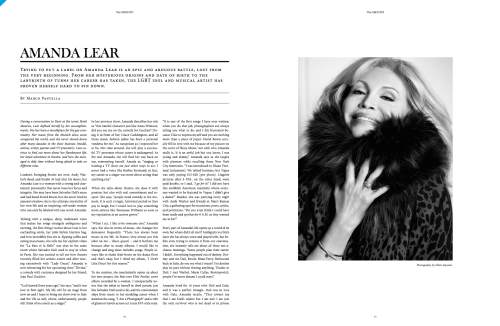
Follow Amanda Lear on Facebook and Twitter
Her New Album “My Happiness” a tribute to Elvis Presley with symphonic arrangements is Out 17/03/14
The GROUND Magazine Issue IV – Globalization and Empowering Women / Buy Online and Stockists here
Marco Pantella Direct Link For this new's Paper !
Trying to put a label on Amanda Lear is an epic and arduous battle, lost from the very beginning. From her mysterious origins and date of birth to the labyrinth of turns her career has taken, the LGBT idol and musical artist has proven herself hard to pin down.
During a conversation in Paris at the iconic Hotel Meurice, Lear defined herself by her accomplishments. She has been a mouthpiece for the gay community. Her music from the Munich disco scene conquered the world, and she never slowed down after many decades in the show business (model, actress, writer, painter and TV presenter). I am curious to find out more about her flamboyant life, her latest adventure in theatre, and how she managed to defy time without being afraid to take on different roles.
By Marco Pantella
Photography / Fabio Esposito
Location / Le Meurice Hotel, Paris
First single, Elvis Presley Reprise
Talking with a unique, deep, trademark voice that makes her songs strangely ambiguous and exciting, the first thing I notice about Lear is her enchanting smile, her pink birkin Hermès bag, and how incredibly fun she is. Sipping coffee and eating macaroons, she tells me her explicit video for “La Bete et la Belle” was shot in the same room where Salvador Dalí used to stay in when in Paris. She was excited to tell me how theatre recently filled her artistic career and after touring extensively with “Lady Oscar,” Amanda is now rehearsing for her upcoming show “Divina,” a comedy with costumes designed by her friend, Jean Paul Gaultier.
“It all started three years ago,” she says, “and it was love at first sight. My life will be on stage from now on and I hope to bring my show over to Italy and the UK as well, where, unfortunately, people still think of me solely as a singer.
”In her previous show, Amanda describes her role as “this hateful character just like Anna Wintour; did you see me on the catwalk for Gaultier? Doing it in front of her, Grace Coddington, and all those mean, fashion ladies has been a personal vendetta for me.” As outspoken as I expected her to be, this time around, she will play a successful TV presenter whose career is endangered. As the real Amanda, she will find her way back on top, reinventing herself. Amada as, “singing or hosting a TV show are just other ways to act. I never had a voice like Barbra Streisand; in fact, my career as a singer was more about acting than anything else.”
When she talks about theatre, she does it with passion, but also with real commitment and respect. She says, “people need comedy at the moment. It is such a tragic, historical period so they pay to laugh, but I would love to play something more serious like Tennessee Williams as soon as my reputation as an actress grows.”
“When I act, I like to be someone else,” Amanda says, but also in terms of music, she changes her demeanor frequently. “There has always been music in my life. In France, they always put this label on me – ‘disco queen’ – and it bothers me because after so many albums, I would like to change and sing more melodic songs. People always like to shake their boots on the dance floor and that’s okay, but I titled my album, ‘I Don’t Like Disco’ for this reason.”
To my surprise, she nonchalantly opens up about her new project, the first-ever Elvis Presley cover album recorded by a woman. I unexpectedly notice that she refers to herself in third person, just like Salvador Dalí used to do, and the conversation skips from music to her modeling career when I mention the song, “I Am a Photograph” and a vibe of glamour travels across our Louis XVI-style suite.

“It is one of the first songs I have ever written; when you do that job, photographers are always telling you what to do, and I felt frustrated because I like to express myself and you are nothing more than a piece of paper. David Bowie actually fell in love with me because of my picture on the cover of ‘Roxy Music,’ not with who Amanda really is. It is an awful job but you know, I was young and skinny,” Amanda says as she laughs with pleasure while recalling those New York City memories. “I was introduced to Diane Vreeland [columnist]. We talked business, but Vogue was only paying $15-$20 [per photo]. Lingerie pictures after 6 P.M., on the other hand, were paid double, so I said, ‘I go for it!’ I did not have this snobbish American mentality where everyone wanted to be featured in Vogue; I didn’t give a damn!” Besides, she was partying every night with Andy Warhol and friends at Max’s Kansas City, a gathering spot for musicians, poets, artists, and politicians. “Do you even think I could have been ready and spotless by 8 A.M. as they wanted me to be?”
Every part of Amanda’s life opens up a world of its own; but where did it all start? Ambiguity is a thick layer she has always worn and played with, but before even trying to remove it from our conversation, she honestly tells me about all these not-a- chance meetings. “Some people plan their career. I didn’t. Everything happened out of destiny. Des- tiny sent me Dalí, Bowie, Brian Ferry, Berlusconi back in Italy, do you see what I mean? I let destiny play its part without forcing anything. Thanks to Dalí, I met Warhol, Maria Callas, Rostropovich, people I’ve never dreamt I could meet.”
Amanda lived for 16 years with Dalí and Gala, and it was a perfect triangle. Dalí was in love with Gala. Amanda recalls, “They always say that I am Dalí’s widow but I am not! I am just the only survivor who is not dead or in prison to tell people about him.” As we laugh again, I try to understand who was “Le Dalí d’Amanda,” a book she wrote about her personal experience with the painter. Amanda says, “I met him when I was young, and he profoundly affected my life. He taught me how to provoke the media and make people talk about me. He was crazy all the time, and he looked like a rock star.” Amanda also clears something up on being his muse: “People do not understand that being a muse is a matter of being physically present. It is not about posing all day; it’s about sharing everyday life. He truly believed he was the best painter on earth, I told him I loved Picasso many times but he did not care, you know?” Could there possibly be anyone else she would have loved to meet? Amanda answers, “Leonardo da Vinci of course – he was such a mysterious and fascinating character like [Johannes] Vermeer. His life is a dark question mark. And inventors like Einstein.”
Living a surreal life can make one want to change reality, and Amanda does it when she holds a brush. Her first real and constant love is painting. Recently, she had been involved in the exhibition on Salvador Dalí in Paris at the Centre Pompidou, and during the summer, “Visions”, was a retrospective of her own work at Milan’s Art Gallery. “It [paintings] never paid the rent,” she remarks sadly, “For me, it is like psychotherapy. Some people drink, others use drugs, and I paint. It helps me [in] dealing with my inner world, my rage, and my dreams and in order for me to keep a balanced life, I need to paint.”
I can almost picture her with Andy Warhol, discussing lithographic reproductions and Jeff Koons. She says, “He [Jeff Koons] does not even make one fucking drawing. Everything is so industrial at the moment and this is not art in my opinion. At least, Andy had an idea behind it. Painting is a very physical work, a long ritual, and I love it because you have to be alone in front of the white canvas. Show business, on the other hand, is all about teamwork.” What is Amanda’s favorite color? “Joachim Patinir’s blue. It drives me mad!”
Despite witnessing many changes in society, Amanda is not surprised by today’s obsession for youth and perfection, teenagers asking for a new nose on their birthdays, and even Madonna’s new pair of cheekbones. People heat up for news like Jodie Foster’s coming out
“Many girls only care about the spotlight. They are manipulated and don’t want to take risks or deal with failure. This is why they all end up making the same music,” Amanda says. What does it feels like for a woman in a man’s world? “People always want you to stay the same way for the rest of your life. Why do we have to choose? Jean Cocteau was a director, a poet and a painter, but when I try to say this, people tell me ‘oh that’s different. He was a genius!’ It is frustrating when they limit you and this is why I titled one of my books, ‘I Am Not What You Think I Am,’” Amanda explains.
" Movies turned in 2008, broadcast in TV 2010 "
" Movies turned in 2008, broadcast in TV 2010 "
Would things be different in the next lifetime? She doubts it: “If I could choose, I would be a man. Women are still slaves in certain countries. For the next few centuries, I’d rather live as a man.” After joking about reincarnating into David Beckham, she continues, “Men though, do not understand that even a powerful woman has to be reassured and protected. We always feel unsafe, and this condition is terrifying.”
Childhood is an off-limits topic. “Nobody cares about it!” Amanda exclaims, “Am I 60? 70? It doesn’t matter. I don’t even celebrate my birthdays; it is a psychological thing pretending that age does not exist, but believe me it works.” Maybe absolute certainty is the reason why she emanates a bright energy that makes me feel like everything is possible. “I would have never believed it if someone told me that one day I’d sell millions of records. Can you imagine [that] with my voice? When I started on Italian TV, I couldn’t even speak Italian properly. It was ridiculous, and yet, it worked out. Now it is the same with theatre, but you never know in life. Maybe one day I will be a famous chef.”
I ask her how she would install an exhibition to represent herself. She says it would include one of her paintings, which is a huge self-portrait similar to the ones seen in royal castles. Amanda adds, “I hold a microphone in my hand as I wanted to say, ‘here is the disco queen you are talking about!’” It would also include a song, ‘The Sphinx,’ where Amanda sings about the desire to remain a mystery
This one is for me, because i love too !!!!Magica !!!
Sometimes, a closer look into an artist’s body of work can reveal the most intimate, 360-degree view of the artist’s mind, life, feelings, and identity. Most of the time, it happens while paying attention to a song that may not have been a global success, but it means the world to the performer. Amanda still remains as a mystery, “a conversa- tion piece, a woman, a priest or a point of view” as the lyrics of “The Sphinx” indicate. However, there is nothing ambiguous about Amanda’s intentions when she looks into a person’s eyes and declares what really excites her is what tomorrow will bring.

Follow Amanda Lear on Facebook and Twitter
Her New Album “My Happiness” a tribute to Elvis Presley with symphonic arrangements is Out 17/03/14
The GROUND Magazine Issue IV – Globalization and Empowering Women / Buy Online and Stockists here
Marco Pantella Direct Link For this new's Paper !

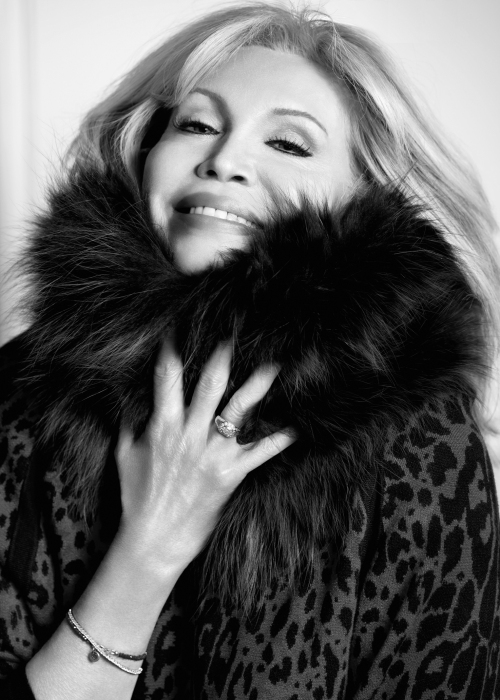
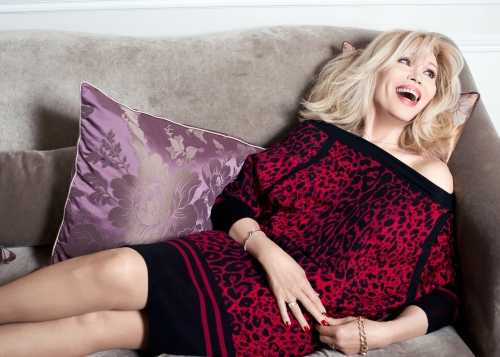
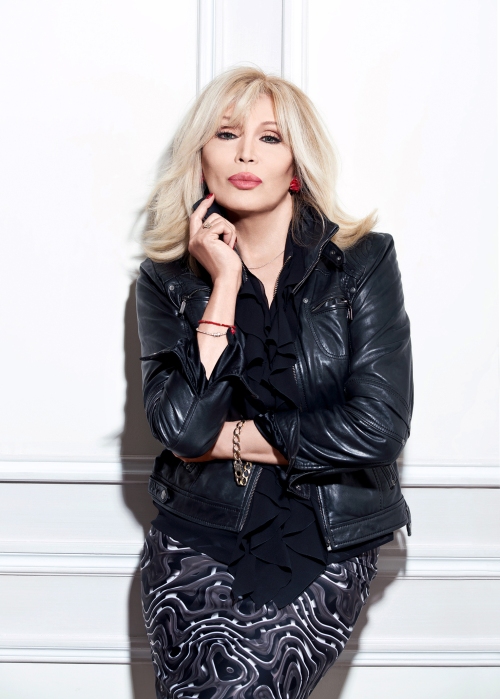
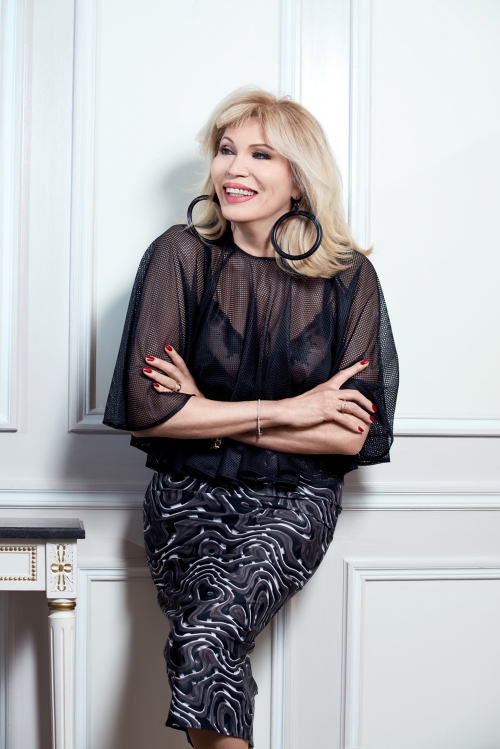
Aucun commentaire:
Enregistrer un commentaire